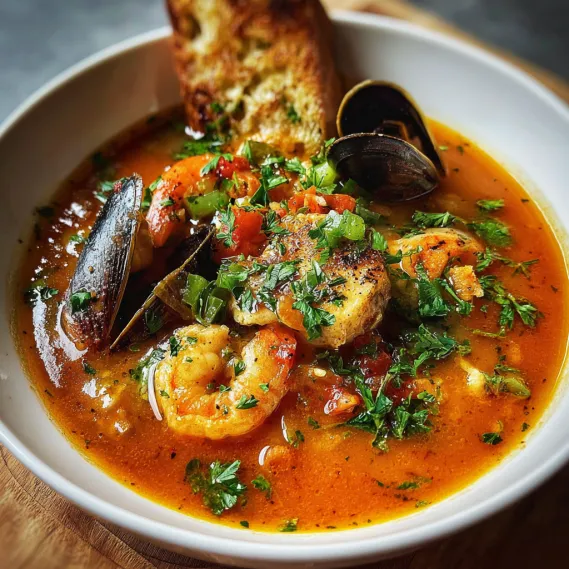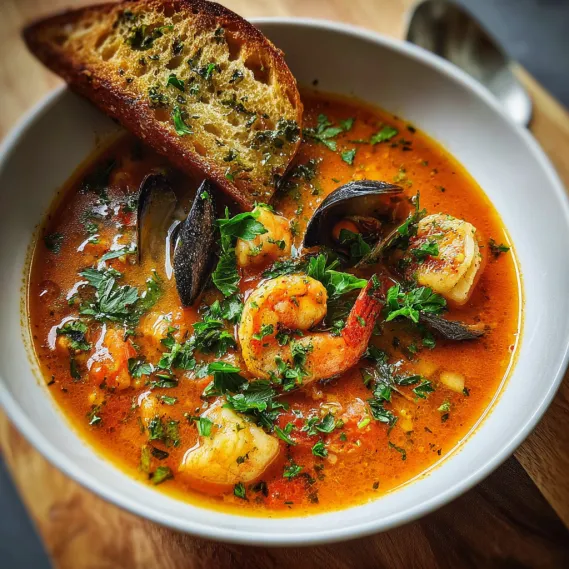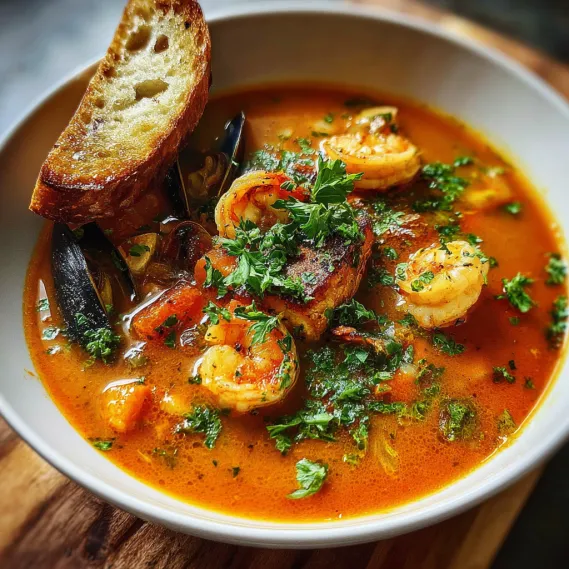 Pin
Pin
This Mediterranean seafood stew brings together fresh fish and shellfish in a lively tomato-fennel broth. The subtle sweetness from fennel balances rich tomato and a touch of heat from chorizo or red pepper. The recipe is comforting yet bright, ideal for special gatherings or cozy weeknights.
When I first made this stew during a windy evening, it transformed our dinner into something you find in a little taverna by the sea. I love how the aroma fills the kitchen and always reminds me of Mediterranean travels.
Ingredients
- Fennel: one large bulb diced gives a sweet anise perfume and keeps texture in the stew look for bulbs with fronds for freshness
- Onion: half a large onion diced forms a savory base pick firm onions without green shoots
- Garlic: four cloves adds punch and depth choose garlic heads with tight skins
- Tomato paste: brings concentrated umami and color try to find double concentrate for richness
- Dry white wine: lifts the flavors and helps deglaze the pan use crisp varieties like sauvignon blanc
- Chicken or fish stock: the backbone for your broth homemade elevates the stew
- Fish sauce: small amount of fish sauce enhances seafood flavor leave out if using fish stock
- Fresh tomatoes or canned: adds brightness and body to the broth ripe fresh or quality canned both work
- Firm white fish: halibut sea bass mahi mahi or black cod holds together in the stew avoid delicate fish
- Mussels or clams: give briny character and tender bite look for ones with tightly closed shells
- Large prawns or scallops: plump and juicy add luxury to each serving select peeled and deveined for ease
- Red pepper flakes: offer gentle heat or opt for cayenne powder for extra spice
- Flat leaf parsley: brightens the finish use fresh with deep green leaves
- Optional chorizo: gives smoky heat Spanish chorizo brings bold flavor Mexican chorizo offers a richer texture
- Lemon for finishing: balances the stew and brings all the flavors together
- Salt and black pepper: seasons everything taste as you go select flaky sea salt for best results
Step-by-Step Instructions
- Brown the Chorizo
- If using chorizo start by heating extra virgin olive oil in a heavy pot over medium heat Remove sausage from casing crumble into bite-size pieces and cook until edges get crisp and color deepens Lift out with a slotted spoon and set aside Pour off excess fat then carefully wipe out the pot to avoid burning
- Sauté the Vegetables
- Add a drizzle of fresh olive oil Swirl in fennel stirring frequently for three minutes to soften but not brown Add onion turn heat to medium and cook both together up to ten minutes You want the mix to become translucent and tender
- Develop the Flavor Base
- Tip in the diced garlic Cook for a further three minutes watch closely so garlic turns just golden not burnt Stir in tomato paste Turn up the heat and cook briskly stir constantly until the paste darkens in color and smells roasted this deepens the stew’s complexity
- Deglaze and Build the Broth
- Pour in the white wine Scrape the bottom to loosen any caramelized bits Let wine bubble until reduced by half Now add your stock tomatoes browned chorizo and fish sauce Bring everything to a simmer
- Season and Adjust
- Add a pinch of salt black pepper and chili flakes to taste Give a good squeeze from half a lemon Taste your broth now it should taste bright balanced and deeply flavorful If using chorizo remember each kind will add different salt and spice levels
- Add the Seafood
- Slip in pieces of firm white fish Simmer just a couple minutes Add prawns or scallops simmer another minute or two Follow with the mussels Cover for two more minutes until mussels open and prawns turn pink Adjust timing if using very large seafood pieces
- Finish and Serve
- Taste again for salt and lemon Squeeze in more lemon if you love a zesty finish Ladle stew into wide bowls Scatter with plenty of fresh parsley Serve with good crusty bread if you like
 Pin
Pin
My favorite touch is adding the lemon at the end it wakes up the whole dish and ties the bright flavors together My youngest always hovers in the kitchen just waiting for a taste when I make this stew It fills the house with warmth and memories
Storage Tips
Seafood stew is best enjoyed fresh but you can store leftovers in a sealed container in the fridge up to two days Avoid freezing as seafood can become tough upon reheating Gently rewarm on the stove to preserve texture
Ingredient Substitutions
You can swap chorizo for a pinch of smoked paprika or skip it for a lighter broth Use cod or snapper if halibut is not available If you cannot find mussels sub small clams or even squid If avoiding wine use more stock and a splash of lemon for acidity
Serving Suggestions
Serve this stew with thick slices of crusty bread brushed with olive oil and toasted You can also ladle it over a small scoop of steamed rice for a complete meal If gluten free add a scoop of tender cannellini beans directly to the pot
 Pin
Pin
Mediterranean Inspiration
Seafood stews like this are beloved in Spain France and Italy Variations can be found in every coastal village Often they are meant to showcase the day’s fresh catch and are generously finished with herbs The fennel tomato and wine combination is a true nod to Southern Europe
Recipe FAQs
- → What types of seafood work best in this stew?
Firm white fish, mussels, clams, prawns, or scallops all hold up well in the simmering broth. Choose your favorites or mix them for best texture and flavor.
- → How can I substitute chorizo if I don't have any?
If you skip chorizo, try adding a pinch of smoked paprika for subtle depth. Spanish chorizo or Mexican chorizo offer different flavors, so adjust seasoning to taste.
- → What sides complement this seafood stew?
Crusty bread, especially rosemary or garlic bread, is perfect for soaking up the broth. For a gluten-free alternative, stir in cooked cannellini beans.
- → Can I make the broth ahead of time?
Yes, prepare the broth with vegetables and chorizo ahead. Add seafood just before serving to avoid overcooking and maintain the best texture.
- → How do I avoid overcooking the seafood?
Add seafood in stages, starting with ingredients needing the longest cooking time. Keep a close eye and remove from heat as soon as everything is just cooked through.
